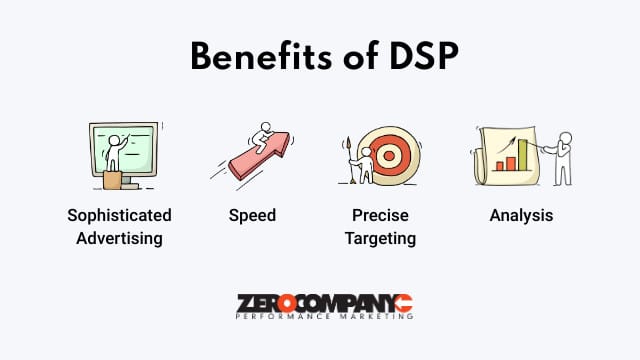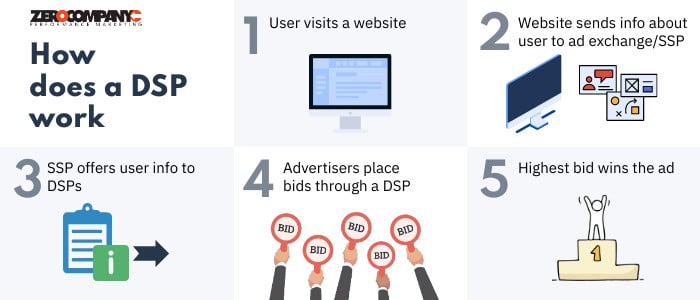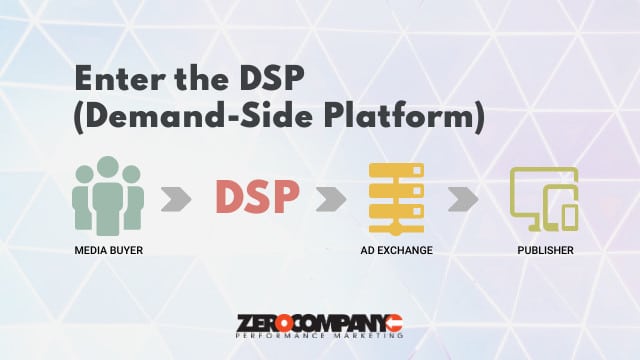What is a Demand Side Platform (DSP) in Programmatic Advertising?
Buying and selling online ad space was not always as simple as it is today. Advancements in data gathering and cloud computing have vastly improved the digital media landscape and given birth to programmatic advertising (Visit our Programmatic Advertising page to learn more about our services).
Thanks to these innovations, a streamlined platform has emerged that has optimized the process of buying and selling ad space on multiple ad exchanges.
Enter the Demand Side Platform (DSP)…So you may be asking yourself the following questions?
Table of Contents
What are the benefits of a Demand Side Platform?
Known best as a DSP, the Demand Side Platform has revolutionized the digital marketer’s ability to manage and run campaigns across multiple channels simultaneously. Not only can they better manage the campaign financially, but every tactic can also be optimized to drive results against a single objective, or KPI, at highly competitive prices.
Thanks to the DSP’s alter ego, the Supply Side Platform (SSP), marketers can choose from a vast array of audience segments, websites, targeting parameters, and platforms when planning a digital media buy.

How does a DSP work?
A DSP allows buyers of digital media to execute campaigns across multiple ad exchanges using a single interface. The users of DSPs include agencies, trading desks and marketing departments, who are able to tap into billions of available ad inventory. By plugging into an SSP, a DSP makes practically every ad impression available for bidding.

Simply put, a DSP is a tool that allows advertisers to organize the ad-buying process and automate campaigns that include display, mobile, video and search inventory from a wide array of publishers.
How is a DSP different from buying directly from publishers?
A key feature of DSPs is the ability to buy a very specific audience segment based on demographic, behavioral, geographic, and predictive targeting. Rather than buying “blocks” of impressions on a specific site, the DSP model allows markets to buy impressions based on the unique qualities associated with a certain IP address or device ID. This way, for example marketers can reach just their target audience, perhaps it is Active ETFs Investors or Investment Professionals. Or if you are a pet dog supply company, you could reach extreme confidence in-market pet owners. Software and IT service companies can literally target CXOs like CTOs, CIOs, CEOs of certain company types or sizes or in certain industries across the open web down to the specific device.
A natural evolution of the ad network, DSPs offer infinite possibilities for ROI tracking and customization. Buying impressions on a DSP is also cheaper, faster, and more efficient than other digital media buying options.
A natural evolution of the ad network, DSPs offer infinite possibilities for ROI tracking and customization. Buying impressions on a DSP is also cheaper, faster, and more efficient than other digital media buying options.
How does a DSP relate to Programmatic Advertising?
The 6 Elements of a Demand Side Platform
While every DSP may have different components or they might call them something different, each of them shares a structure where these six pieces fulfill their role in allowing the creation and execution of programmatic advertising.
Here is a look at the 6 components that make a DSP
1. The Bidder
Perhaps the most important player in the DSP landscape, it is the bidder that actually buys the ad impressions, using the RTB option. Because this process occurs in milliseconds, it is crucial for DSPs to execute the bid as quickly as possible. In order to minimize slowdowns, most DSPs utilize multiple data servers around the world. A DSP can even forecast the impression bids based on historical data.2. The Server
A highly sophisticated server is what actually serves the right ad on the right website to the right person. Ad servers also measure the impact of each impression by tracking conversions, clicks, and other data, which is used in the optimization process. Fraud prevention is another key element of the ad server, so a server must also be used to detect fraudulent ad inventory.3. ROI and campaign tracking
The ability to measure, track, and record campaign data awaits anyone who uses a demand side platform. In fact, this is one of its key selling points. People who love data will enjoy the various metrics used to evaluate digital ad campaigns. Buyers can learn about ad effectiveness, including the number of impressions, clicks, and conversions, as well as the number of viewable impressions. Most of these metrics will be shown on the reporting dashboard, where they can be applied to optimizations.4. User data
Whenever an ad is served by a DSP, it records certain information about the user on the receiving end, based on the type of content they consume and which ads they tend to click on. As you can imagine, this amounts to mountains of data about user characteristics and allows the DSP to place them in a very specific audience segment. User profile data is then utilized to enhance optimization and remarketing efforts.5. Budget parameters
The primary element of a DSP that makes it so efficient is its ability to keep campaigns within certain budget parameters while still accomplishing campaign goals. The budgeting feature allows marketers to set a max budget, set the pacing, and define other rules pertaining to bidding and frequency.6. Integration with exchanges and SSPs
Data management platforms, brand safety solutions, payment gateways, and analytics providers all play a role in the operation of a demand side platform. By integrating these tools, DSPs have centralized and consolidated the ad buying process, thereby allowing advertisers a single, multi-channel platform to diverse groups of consumers.Full-Service or Self-Service – Which is Best for You?
Self-serve DSPs
For the bravest among you, this option provides the advertiser DSP access where they can buy advertising, create campaigns, select audience datasets, and view reporting. Self-serve DSPs are often used by companies with in-house agencies or by individuals with prior experience in digital marketing.Full-service DSPs
This option operates more like a full-service ad agency. A client of a full-service DSP might work directly with an account manager to determine the right budget, KPIs and creative approach to their campaigns. Because they handle everything from start to finish, this option can be more expensive, but oftentimes the increased efficiency and subsequent results more than cover the added costs.Conclusion
Ad advertising exchange is the marketplace that enables publishers and advertisers to sell and buy ad space using its real-time bidding platform. Think of it as a broker, or “go between” in the world of programmatic buying. With its inventory coming from SSPs and being purchased through DSPs, the exchange presents each impression in real time, asking buyers if they are interested in buying and allowing the demand to set the price.
While some demand side platforms come complete with a team of digital experts, others are self-serve platforms that allow individuals and businesses to run their own trading desk. In order to manage campaigns on a DSP, a lengthy training program would be needed.







